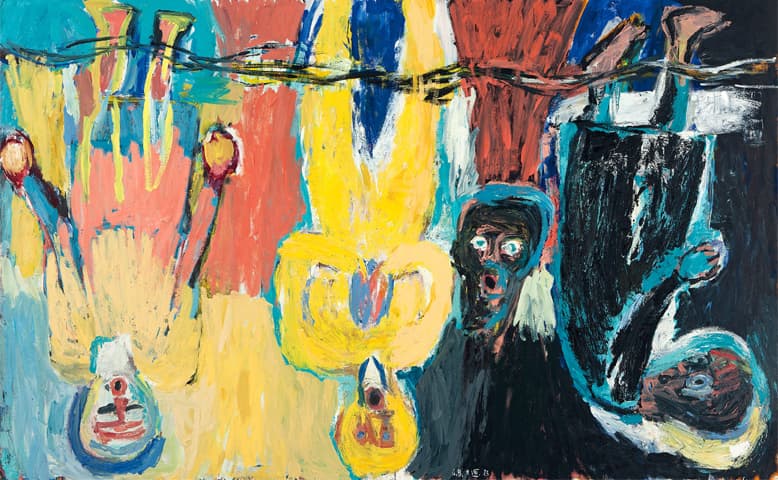
Of all the big, bloated reputations in contemporary art over the past 40 years, few can compare with that of Georg Baselitz. Julian Schnabel would be a contender, but no one besides Schnabel has taken his art terribly seriously for years.
Baselitz is the subject of a retrospective, his first in the United States for 20 years, at the Hirshhorn Museum. You really have to begin by asking why. As with a lot of things that seem wrong with the world and, on the face of it, easily fixed, the answer is mostly inertia.
Quite simply, too many people have paid too much for Baselitz’s blowzy work over too many years for his reputation to undergo the correction it warrants. Too many curators and collectors have placed their chips on the roulette wheel of his talent.
The Hirshhorn show has come to the nation’s capital from the Fondation Beyeler in Basel, Switzerland. It includes more than a 100 works — expressionistic paintings (mostly huge), works on paper and several of the artist’s big, chunky sculptures.
Carved from lime, cedar or birch (and lately cast in bronze) and splashed here and there with brightly coloured paint, the sculptures are easily Baselitz’s most successful works. They’re crude, rude and oddly touching. Encountering one is like happening upon a smiling, cross-eyed giant cradling a kitten he has just decided, for no particular reason, not to drown. They look rightly pleased with themselves.
But it’s on painting, not sculpture, that Baselitz’s reputation rests, and it’s on his talents as a painter that he demands to be judged.
You could blame the fact that his idiom — neo-expressionism — came in and out of fashion in the 1980s and never convincingly re-emerged. But the problem is more specific than that. His work may vaguely remind you of Edvard Munch (his great hero) or of the German expressionists associated with Die Brücke. But he has never quite managed to tie his influences and the various other threads of his sensibility into taut and commanding art.
Baselitz turned 80 this year. He was born in Deutschbaselitz, in a part of Saxony that became East Germany after World War II. In 1957, after just two terms at East Berlin’s Academy of Fine and Applied Arts, he was expelled for “socio-political immaturity” — an Orwellian euphemism of the first order. He moved to West Berlin later that year. Born Hans-Georg Kern, he changed his name to Baselitz, after his home town, in 1961.
He came to prominence in 1963, when two paintings in his first solo show were confiscated by the state attorney’s office. One of these, ‘The Naked Man’ kicks off the Hirshhorn retrospective. It depicts a cadaverous man with a huge erection lying on his back on a table. An aura of obscured sensation surrounds the work. Beyond the obvious obscenity, you want to know what exactly it was about this, and the other painting, ‘The Big Night Down the Drain’, that proved so contentious. But truthfully, in front of the painting itself, your curiosity wanes.
In Baselitz’s best early work you can detect something like the tense, Teutonic, psychologically thwarted sensibility artists like Neo Rauch would later distil and push into more compelling territory. The mid-1960s series Baselitz called Heroes — cramped, broad-shouldered figures burdened by a broken-down network of symbols and attributes — as in Albrecht Dürer’s ‘Melencolia I’ and the so-called ‘Fracture Paintings’ that followed, suggest an artist of promise.
But by the 1970s, Baselitz had already begun to careen about like a deflating balloon. Looking at his oeuvre as a whole, what becomes clear is that his sense of colour is haphazard and his drawing weak. His painterly touch, meanwhile, is clotted and directionless, unredeemed by the splashes and drips he introduces into compositions that hit the eye like jelly that’s yet to set.
Some great artists cultivate cack-handedness. They treat technique as an impediment to poetic flow. Others achieve greatness by pushing through or against their technical limitations. Baselitz imitates the manner and look of both kinds of artist, experimenting with splatter and finger painting and mixed media and whatever else occurs to him.
But the results remain drowsy and inchoate. He is like the bore at a party who, determined to create a stir by smashing decorum, tries one gambit after another. Rudeness! Charm! Political controversy! Unwanted intimacy! Standing on your head! It’s an impressive performance, in a way. But everyone goes home asking, what was that?
Baselitz did, in fact, try a version of standing on his head. Beginning in 1969, he began displaying his paintings upside down. No one, to my knowledge, has ever made adequate sense of the strategy. The exhibition wall text speaks of Baselitz’s desire to reduce “the images to base formal qualities of line, shape, and colour,” to “question the subservience of the painting to the image” and to “free the image from its predetermined meaning.”
Whatever. The comedy of watching art aficionados standing in front of these canvases and trying to resist the urge to turn their heads upside down, the better to see them, is a consolation, of sorts.
“Baselitz: Six Decades” is being displayed at the Hirshhorn Museum, Washington, DC from June 7 to September 1, 2018
By arrangement with The Washington Post
Published in Dawn, EOS, August 5th, 2018
















































Dear visitor, the comments section is undergoing an overhaul and will return soon.